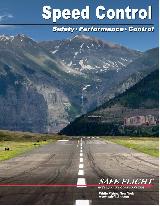Speed Control System
Click here to request additional info about this product
Features:
- Optimize the performance capabilities of the aircraft
- Maximize performance for short field operations
- Stall Warning
- ARINC 429 and analog output for “Glass”
- Low Airspeed Awareness – LAA
- AoA Output
- Flap compensation
- Ice Mode – Flight Into Known Icing
Speed Control System Benefits:
- Combines speed control, LAA and stall warning
- Shows continuous stall trend information
- Single Angle of Attack wing-mounted sensor
- Integrated into a PFD or Stand-alone Display
- Low Airspeed Awareness (LAA) Output
Description
The Safe Flight Speed Control System consists of a wing-mounted Lift Transducer and a Stall Warning LAA Computer.
The Lift Transducer is installed in the lower leading edge of the aircraft wing. The Transducer vane protrudes into the airstream and is positioned during flight by local airflow velocity and direction.
By correlating lift with airflow characteristics at the stagnation point on the wing, the Lift Transducer measures minute changes in angle of attack, represented as an airspeed deviation from a reference angle of attack.
The output signal, combining angle of attack and local dynamic pressure, is processed by the computer and is displayed visually on the PFD or on a stand-alone indicator (If desired, the computer function can also be integrated into a 2″ Indicator).
The display shows FAST and SLOW limits referenced to the AoA-based reference speed.
Low Airspeed Awareness (LAA) symbology is integrated into the Primary Flight Display (PFD).
The measurement accuracy of the system (expressed in knots deviation from the reference speed) is usually within one knot.
Operation
The Speed Control System, one of a third generation of Safe Flight’s precision lift measurement systems, provides the pilot with the lift information the pilot needs to optimize the performance capabilities of his aircraft.
This continuous cockpit display enables the pilot to evaluate the lift performance of his aircraft instantly, regardless of gross weight, wing loading, air density, attitude, ground effect, turbulence or flap/gear configuration.
The position of the indicator pointer relative to the STALL zone shows the current proximity to stall, as well as the trend toward or away from the stall condition over time.
The reference marks at either side of the centermark are provided as targets below and above the reference speed. These marks can be used for maximum performance short field operations at the SLOW mark, and for less critical or turbulent approaches at the FAST mark.
In addition, the system can provide an output to drive the aircraft stall warning device.
Speed Control System
- Best climb angle
- Best engine-out climb for multi-engine aircraft
- Proper speed / attitude during approach
- Instantaneous stall trend information
- Best short field approach speed and attitude
- TSO
For more information regarding Safe Flight’s various Angle of Attack applications, click on a link below.


